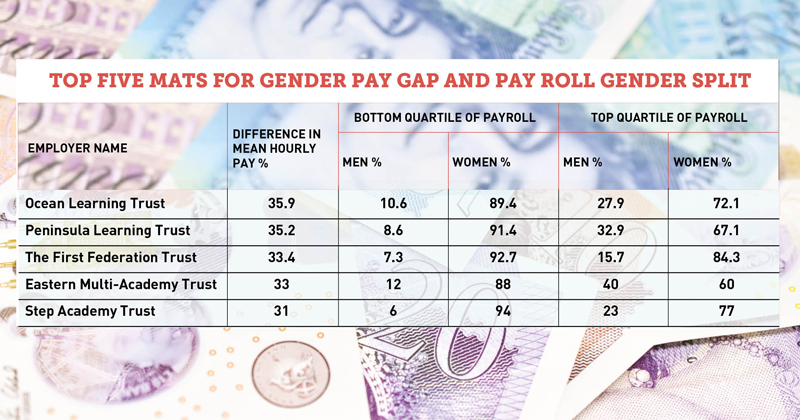Primary school academy trusts have the largest pay gaps between men and women according to new national data – and senior figures are pointing to the high numbers of female staff in low paid roles as the main reason.
The government announced in April 2016 that academy trusts and schools with more than 250 workers would have one year to publish their gender pay gap statistics.
Reports are published online and show the median and mean gender pay gap, as well as the proportion of men and women in each quartile of the pay structure.
Women’s pay is lower across all of the multi-academy trusts which so far have published their data and two in five pay their male staff at least 25 per cent more on average than women overall.
But the trusts with the largest gaps say the figures are skewed by the proportion of women in lower-paid jobs, a situation most common in trusts dominated by primary schools. In fact, three of the top five trusts with the largest gender pay gaps were all-primary.
Ocean Learning Trust had the largest gap: women earn 35.9 per cent less than men on average. The trust, an all-primary MAT in Bournemouth, Poole and Dorset, declined to comment on the figures.
In Cornwall, the Peninsula Learning Trust, which has seven primaries and one secondary, had the second-largest gender pay gap at 35.2 per cent.

A spokesperson told Schools Week the gap was a result of “the structure of the workforce” and that “no discrimination takes place between men and women at Peninsula Learning Trust”.
The First Federation Trust, one of England’s first primary federations, had the third-highest pay gap at 33.4 per cent. The trust has 10 primary church schools and four secular schools across Devon.
Its CEO Paul Walker said that “nationally there are usually more male employees in senior positions”.
He claimed that First Federation has equal pay for men and women in “all similar posts”, but the majority of the trust’s workforce are in lower-paid teaching and support posts held by women.
Education is supposed to be a profession about equity, inclusion and fairness
This is often because of a choice to “work around having and caring for children”, he said.
“Men hold under 10 per cent of the roles in the lower quartile; the directors have noted that there are very few male applicants for these roles.”
Eastern Multi-Academy Trust, which has 12 primary schools and two secondaries, ranked just below First Federation with a gap of 33 per cent.
It acknowledged that career progression is “particularly affecting the gender pay gap within the trust”.
“The trust is also looking to implement leadership development programmes for those aspiring to middle and senior leadership to enable equal access to all staff,” it said.
Vivienne Porritt, the co-founder of campaign group WomenEd, said Schools Week’s findings were “not a surprise”.
“Education is supposed to be a profession about equity, inclusion and fairness. This data will ensure education institutions can be held to account,” she said.
She advised trusts not to “wait for somebody else to say you need to do it”.
“Use this data to say we can do targeted programmes for women leaders, we can offer them coaching, we can be asking the women themselves about this, and drawing on organisations such as WomenEd for support.”






I wonder if this is more reflective of the fact that in primary education the vast majority of teachers are women. I’ve stood in primary schools’ reception areas and seen a photo wall of all the teachers and counted one man among them. If you have a scenario where the senior executive team at a school is split 50/50 genderwise, but 90% of the teachers are female, then on average (looking over the whole workforce) men will be paid more than women. This is the case even if female senior executives and male senior executives (and female teachers and male teachers) are paid exactly the same.
Have I missed something, or wasn’t this outcome about ‘average pay in primaries’ always going to be the case?
(By the way, I do think the imbalance in the teacher make up is a big problem, but that’s another story…)
The TA’s are most likely women too, as are the dinner ladies and any lunchtime supervisor roles. The data needs to be broken down into number of people as well as each salary scale so we can see. WomenEd are being disingenuous in their comments as they will seize on anything at the moment but if we want to see evidence of an actual pay gap then we need to see like-for-like.
Schools Week need to get their act together in terms of analysing statistics.
Just following this up with an (overly simplified) example.
Consider a primary school where all women are paid 10% more than the equivalent men.
There are five people making up the senior executive – two are men paid £60k and three are women paid £66k.
There are 33 teachers – three are men paid £30k and thirty are women paid £33k.
There are 11 support staff (TAs, catering etc) – one is a man paid £20k and ten are women paid £21k.
I presume it is agreed that the salaries paid at this hypothetical school are prejudiced in favour of women. Also there are more women senior leaders than men.
However, on average, men are paid 18% more than women (£38,333 for men versus £32,512 for women).
Headline statistics like this are meaningless.
BTW this is certainly not meant to say we don’t have a wider problem with gender pay inequality – I absolutely think we do.
But when you look at primary schools I would suggest the real problem is not pay differentials but the gender balance in the various roles. The chronic lack of male primary school teachers is a societal problem, but something that deserves to be seriously considered. I don’t know what the figures are for senior leaders – how many primary heads are female, how many male etc – but again if that is unequal (whichever way) it should be looked at.